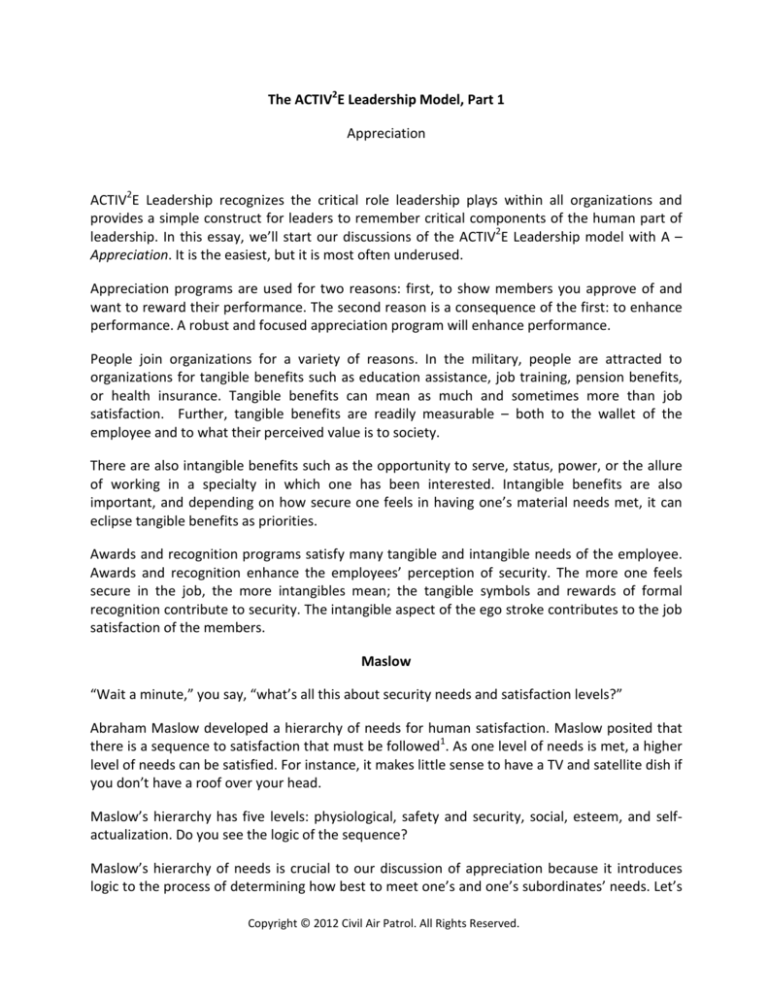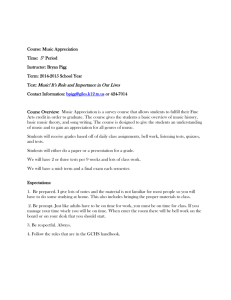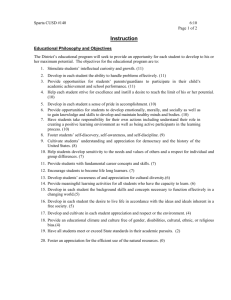
The ACTIV2E Leadership Model, Part 1
Appreciation
ACTIV2E Leadership recognizes the critical role leadership plays within all organizations and
provides a simple construct for leaders to remember critical components of the human part of
leadership. In this essay, we’ll start our discussions of the ACTIV2E Leadership model with A –
Appreciation. It is the easiest, but it is most often underused.
Appreciation programs are used for two reasons: first, to show members you approve of and
want to reward their performance. The second reason is a consequence of the first: to enhance
performance. A robust and focused appreciation program will enhance performance.
People join organizations for a variety of reasons. In the military, people are attracted to
organizations for tangible benefits such as education assistance, job training, pension benefits,
or health insurance. Tangible benefits can mean as much and sometimes more than job
satisfaction. Further, tangible benefits are readily measurable – both to the wallet of the
employee and to what their perceived value is to society.
There are also intangible benefits such as the opportunity to serve, status, power, or the allure
of working in a specialty in which one has been interested. Intangible benefits are also
important, and depending on how secure one feels in having one’s material needs met, it can
eclipse tangible benefits as priorities.
Awards and recognition programs satisfy many tangible and intangible needs of the employee.
Awards and recognition enhance the employees’ perception of security. The more one feels
secure in the job, the more intangibles mean; the tangible symbols and rewards of formal
recognition contribute to security. The intangible aspect of the ego stroke contributes to the job
satisfaction of the members.
Maslow
“Wait a minute,” you say, “what’s all this about security needs and satisfaction levels?”
Abraham Maslow developed a hierarchy of needs for human satisfaction. Maslow posited that
there is a sequence to satisfaction that must be followed1. As one level of needs is met, a higher
level of needs can be satisfied. For instance, it makes little sense to have a TV and satellite dish if
you don’t have a roof over your head.
Maslow’s hierarchy has five levels: physiological, safety and security, social, esteem, and selfactualization. Do you see the logic of the sequence?
Maslow’s hierarchy of needs is crucial to our discussion of appreciation because it introduces
logic to the process of determining how best to meet one’s and one’s subordinates’ needs. Let’s
Copyright © 2012 Civil Air Patrol. All Rights Reserved.
just take a minute to examine each level of needs. For those who are already familiar with
Maslow’s hierarchy, consider this a brief review.
Physiological Needs
Physiological needs deal with the most basic needs for human survival: food, shelter, oxygen,
water, and environment. It is the most basic measure of human fulfillment.
Safety/Security Needs
This addresses the human need for protection against danger and threat. These dangers can
come from the environment, organizations, animals, and humans. Safety issues can involve
crime, recessions, and physical dangers. It is the first level of psychological needs and is critical.
One doesn’t have to BE in danger to FEEL in danger. When one FEELS in danger, nearly
everything else is subordinate.
Social Needs
Once basic physiological and security needs are taken care of, the individual can begin to look
outside of themselves. They begin to look for social reinforcement – the development of peer
groups at work, and the building of respect.
It is here where awards and recognition really begin to do their work. Most often, recognition
helps build acceptance within a peer group. There is a basic need in all of us to be recognized
and appreciated for our efforts. It’s a powerful motivator for leaders to harness if they want
their people to go to the next level.
Esteem needs
Awards and recognition also fill esteem needs. Esteem refers as much to one’s view of
themselves as well as how others view them.
If someone is given only negative feedback – or no feedback whatsoever – there is little
motivation to progress. The person may feel their contributions are unwanted or insufficient,
and in time their feeling of self-worth decreases. People leave when they feel they aren’t
wanted. When this happens, corporate knowledge goes with them.
Self-Actualization Needs
This category refers to the highest level in the hierarchy in which one desires to have a purpose
in life, and to fulfill that purpose. The individual taps all their talent and potential towards that
goal. It is being satisfied with one’s life and the journey within that life. This level cannot be
accomplished until all other needs are met.
As a leader, should you worry about self-actualization needs? Yes, but… awards and
appreciation really talk to security, social, and esteem needs.
Copyright © 2012 Civil Air Patrol. All Rights Reserved.
As a leader, you must meet the lower-level needs of your people before you can satisfy higherlevel needs. For instance, a member must feel secure in their position before you can really
affect their esteem. This doesn’t diminish the needs to show appreciation and develop their
esteem and social standing within the organization; but it does give you an idea of how to focus
your efforts.
Formal and Informal Appreciation
True appreciation programs, formal or informal, are based on merit. Merit builds value
(performance). There are countless ways to show employees/members appreciation for their
performance. True limitations are cost of the measures and the commitment of the leader.
Informal Appreciation
Former CAP National Commander, Brig Gen Richard L. Anderson – knows the power of informal
appreciation well. He loves to write notes to anyone over anything to tell them he appreciates
what they do.
For instance, he wrote to every CAP cadet who earned CAP’s highest award for cadet
achievement and was promoted to Cadet Colonel. Imagine for a minute being a 16, 17, or 18year old kid getting a handwritten letter of congratulations from “the General.”
The simple sincere “Thank you” is a great way to show your appreciation. It shows that you
noticed – particularly if it’s done right away; and besides, it’s good manners. E-mail notes with
copies to your bosses are even better, because it spreads the word that you have someone good
working for you.
Other forms of “informal” appreciation (though they could be included formal programs) are
coins, gift certificates, a Friday pizza lunch (for a group), etc. Anything that shows you’ve noticed
their good work. By the way, it also reflects well on you. It shows that you look outside of
yourself to notice and respect others. In return, you’ll be more respected by your subordinates,
your peers, and your boss.
Formal Appreciation
Formal appreciation programs can be as simple or as complex as you want them to be. The local
grocery offers an Employee of the Month with the employees’ picture at the front of the store
and a plaque. The Boeing Company offers everything from certificates to cash bonuses to free
days off. The Air Force offers spot promotions to enlisted personnel (called STEP promotions),
cash incentives for suggestions, medals for performance and conduct, and other awards.
As you know, CAP has an extensive formal awards and decorations program. Beyond certificates
and ribbons, CAP also has awards recognizing outstanding performance in each of the mission
areas as well as annual awards for exceptional staff service. These awards are easy to start into
the pipeline. For instance, any member can recommend any other member for CAP
achievement Award or other commendation using the CAP Form 120. Same’s true for lifesaving
Copyright © 2012 Civil Air Patrol. All Rights Reserved.
and valor awards. It’s not hard at all, all that’s required is first-hand knowledge, supporting
documentation, and a few minutes to write a well-thought paragraph or two about the event.
Whatever the method, when used well, formal recognition/appreciation programs offer
opportunities for both the boss and member. For the member, it offers tangible proof of
performance. For the boss, when used well, recognition/appreciation programs will enhance the
performance and morale of all members. The mission is accomplished quicker, the goals met
faster, and the bottom line is enhanced. Investments pay off.
Six Simple Rules About Appreciation Programs
There are six simple rules to remember when constructing an appreciation program. It can be
summarized as: MEMBER.
Make it comprehensive
Ensure everyone can play
Make it count
Build value in the program
Ensure everyone does play
Resonate a culture of appreciation
Make It Comprehensive
A good appreciation program recognizes all types of achievement for all durations. Since one of
the main objectives of an appreciation program is to enhance performance; recognition of good
performance and effort is key.
Recognition and appreciation can touch employee conduct off the job as well. A formal letter of
congratulations or certificate of accomplishment to reward a member for getting an advanced
degree or certification not required for the job, for example; it shows you approve of their
development. So too would formal recognition of a member’s civic activities.
On the job recognition should be for short and long-term accomplishments, exceptional
completion of special projects, or for sustained performance. The point is to give the members
many opportunities to succeed, and show they are valued more than as the revenue they
generate.
Copyright © 2012 Civil Air Patrol. All Rights Reserved.
There is, however, a fine line: while you want the program to be comprehensive, you don’t want
it so easy so as to diminish its meaning. Don’t be stingy, but don’t pass awards out like peanuts
in a ballpark either. Preserve its value.
Ensure Everyone Can Play
To build a truly comprehensive recognition/appreciation program, as many members as possible
should be eligible to participate. Lately, it’s become fashionable in some areas to say that once a
member reaches a certain level, they shouldn’t need to be included because they are already
well recognized. But that just doesn’t make sense. While formal recognition/appreciation
programs use tangible rewards, it’s done to build the spirit of the member and the team and
enhance their performance. Most of the benefit is in the mind of the receiver – or potential
receivers. Why shoot yourself in the foot by saying some people can’t be thanked?
Make It Count
Sincerity is key. A recognition/appreciation program should not be started because some
leadership recipe calls for it. It should be done because the leadership really believes it will
enhance performance and that it’s the right thing to do for the members. If the effort is not
sincere, it won’t succeed, no matter how much money is thrown at it.
Build Value in the Program
Appreciation programs (from a follower’s viewpoint) build value in two ways. First, they build
tangible value. The forms of appreciation selected reflect a commitment of the organization’s
value.
The second way recognition/appreciation programs build value: intangibly through showing
genuine interest in members and genuine recognition for the roles they play in the success of
the organization (back to the sincerity we discussed briefly).
Ensure Everyone Does Play
Have you worked in places where the bosses didn’t put their people in for awards. Notionally,
there are three reasons for this:
1. They just didn’t think about it.
2. There was a problem within the department, and the boss thought that if people were
rewarded in the midst of the problems, it would be viewed as condoning the problems.
3. The boss felt that the system itself was unfair since not everyone was eligible; and to spare
the feelings of those whom the system left out, no one would be recognized.
Copyright © 2012 Civil Air Patrol. All Rights Reserved.
Certainly the first reason is the least complicated. The boss who doesn’t think about it – from a
follower’s perspective – is missing a powerful motivation tool and may exhibit a lack of
emotional intelligence.
It’s more useful to examine the last two reasons because they are more complex. Working in, or
leading a problem department is a challenge indeed. It’s admirable for anyone rising to take the
reins of a department or unit in troubled times. The boss must clearly delineate expectations for
success, as well as to spell out what behavior is unacceptable.
That said, to issue a blanket policy which has the effect of preventing recognition of members
who do well – even in troubled times, is flawed.
In fact, it may be here where awards and recognition can be especially useful. It’s an extremely
visible and flexible way to highlight successful behaviors without coming off as “preachy.” Most
members in a troubled department want to do the right thing and want to be successful, all they
need is to be shown the way. Those recognized or awarded provide an example for others to
emulate. As they begin to view themselves as successful, they build on that momentum.
The last reason is the most complex. It’s hard to leave people out – especially when everyone is
performing well. Whether this is a good strategy is more dependent on how all your members
feel. It’s not a decision to be taken unilaterally. And, regardless of the decision reached by the
group (democratic style of leadership), if the boss truly feels the system is unfair it is also
incumbent on the boss to work to change the system to one that is equitable for all members.
Resonate a Culture of Appreciation
This brings us to resonating a culture of appreciation – where the formal and informal pieces
come together. To be emotionally intelligent enough to know it’s always okay to thank someone
for their work. To breed the culture up and laterally as well as down the hierarchy. To be aware
enough to thank someone, help someone, appreciate someone when no one else is looking or
would ever know.
So what’s the punch line? You don’t need a lot of money, you don’t need a lot of people, what
you need is the will and the sincerity. Remember the MEMBER!
Notes
1. Abraham Maslow, Motivation and Personality, 2nd ed., Harper & Row, 1970.
Copyright © 2012 Civil Air Patrol. All Rights Reserved.







